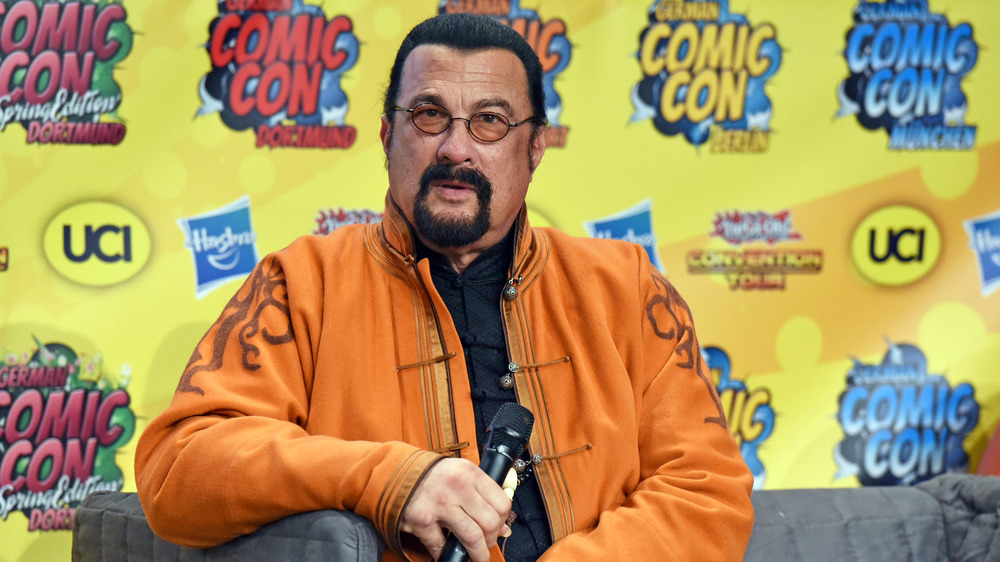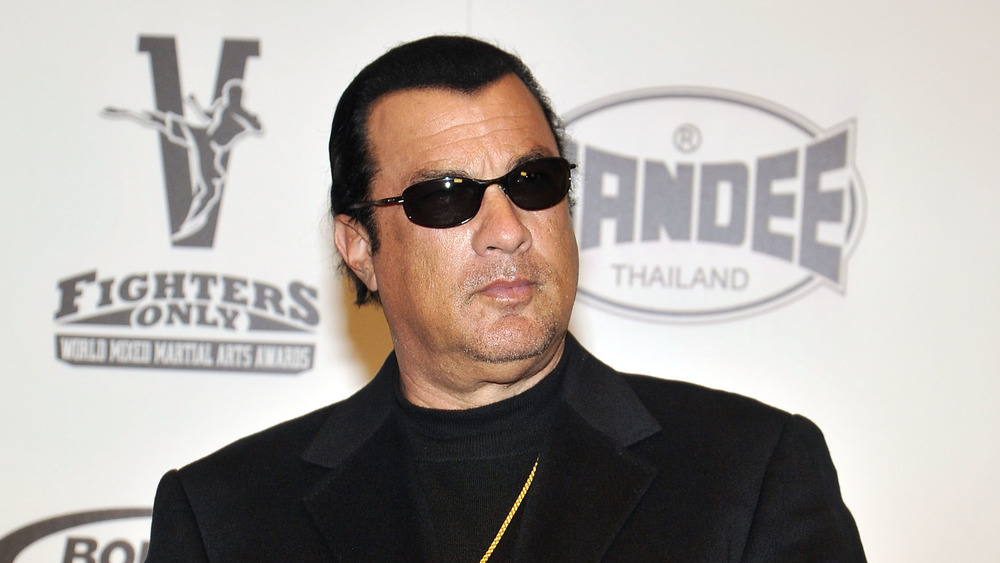Why The FBI Went After Steven Seagal
Steven Seagal: Russian citizen, hair plug cautionary tale, embarrassment to Aikido, 21st century direct-to-video DVD icon, and one-time Hollywood blockbuster semi-star whose ticket sales through the '90s garnered over $1 billion, per the LA Times. Seagal, no matter what's befallen him in the past couple of decades, remains forever enshrined in the pantheon of second-tier 1980s and '90s action stars that includes Jean-Claude Van Damme, Dolph Lundgren, Michael Dudikoff, and a host of honorary mentions. At his peak, Seagal was "no Harrison Ford," according to Hollywood publicist Howard Bragman, but still, he did all right enough.
In a fun reversal of his typical vigilante roles, though, Seagal himself was once embroiled in a stratagem of subterfuge and intrigue against one of the United States' chief legal authorities: the FBI. One could say the FBI were... Out for Justice. They thought that Seagal considered himself... Above the Law. But even though Seagal was Under Siege, and may have Marked (a journalist's car) for Death, who considered herself Under Siege 2, ultimately, the FBI made an Executive Decision to not attribute the car's bullet-hole Exit Wounds to him. Officially, he was never charged, but also never cleared, and has remained On Deadly Ground with Hollywood ever since (okay, he's basically been blacklisted). But even though Seagal never got the apology he believes he deserved, he will, to himself, always remain The Patriot that he knows he is. And if we forget that salient fact, odds are, he'll find a way to remind us.
'I'm gonna take you to the bank... to the blood bank.'
Seagal's one-time law-flouting saga began with Anthony Pellicano, who is not only the most (apparently) non-mafia man with a quite-mafia name, but was once Hollywood's chief detective to the stars. But really, Pellicano was always more of a strongarm than an investigator, who, as The New York Times says, would drive around Los Angeles with a baseball bat in his trunk. Not, apparently, in case he ran across a quick sandlot pickup game. No, it was in case he needed to conduct some impromptu intimidation. In 2019 he was released from prison after a 15-year sentence for operating a vast surveillance network that conducted illegal wiretaps on actors such as Sylvester Stallone. Pellicano worked with a lot of people, including Chris Rock, Courtney Love, and yes, Steven Seagal. That is, until the early '90s, when Seagal said they stopped being on speaking terms.
A decade or so later, in 2002, Anita Busch, reporter for Variety, The Hollywood Reporter, and later The New York Times, was working on a story uncovering "unflattering" information about Seagal and a former business associate. At the time, per The New York Times, she was also collaborating with The Los Angeles Times in a piece about "organized-crime links to the entertainment industry." On June 20, Busch found a note taped to her car in the morning that said "Stop," aside a fish and rose in a tin tray on the windshield. And next to that, a tiny hole that looked like a bullet hole.
'I think we're living in a world where society is very difficult'
When Busch first reported the incident, she received little but "snickers" and mockery, especially from New Times in Los Angeles, a rival Los Angeles newspaper that has since gone out of business. In fact, she was even accused of having made up the entire incident. "I was telling the truth, and no one was believing me," Busch said. "People started questioning whether I had somehow lost my mind." Busch's supporters said that such responses were driven by jealousy at her career and ability to uncover the truth.
Eventually, the FBI approached Seagal as a suspect in the case, who said it was absurd that he would hire Pellicano to terrorize Busch. In a public statement, Seagal blamed this accusation for crippling his career, saying, "These kinds of inflammatory allegations scare studio heads and independent producers — and kill careers." Admittedly, Seagal passed a polygraph test that indicated he was telling the truth.
The investigation moved to Pellicano himself. Six years later, in 2008, Busch finally took the stand in a trial whereby Pellicano and six associates were brought up on no less than 110 charges of spying and illegal wire tapping. As a result, Pellicano served time in prison all the way until 2019, when he was released. Seagal, for his part, got off completely free. It seems he really might be Hard to Kill after all.


